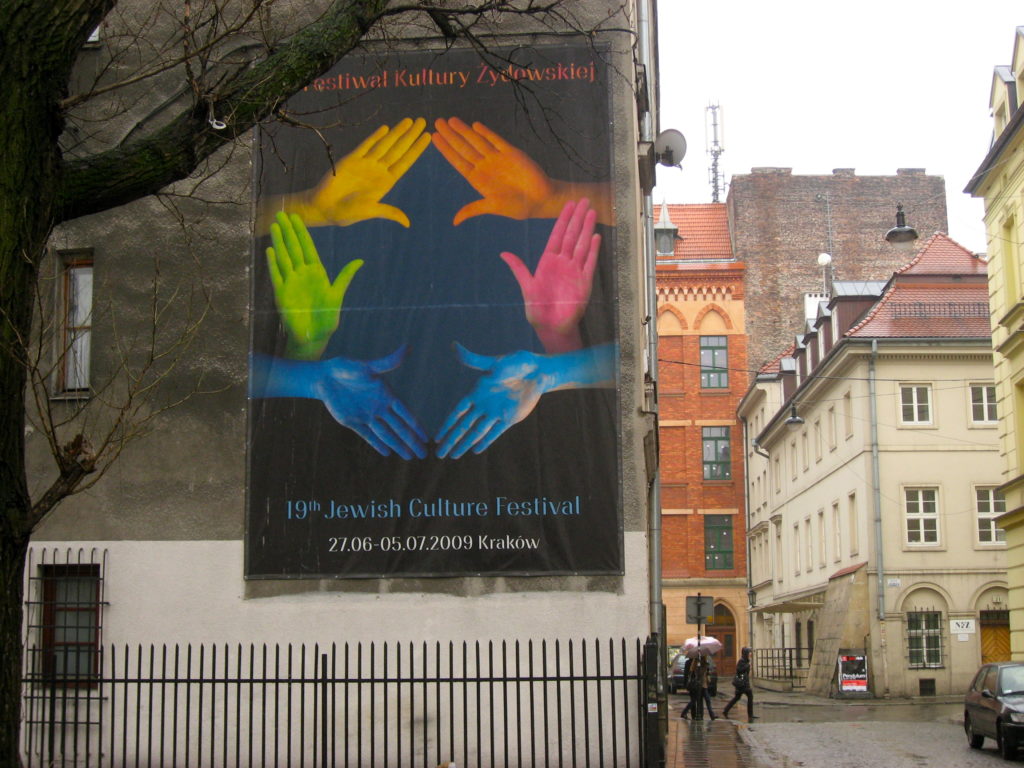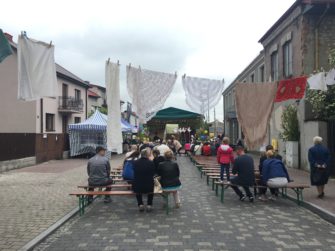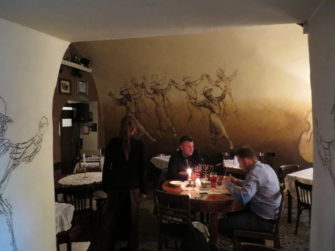
We know from a vast and rich literature that “secularization” is a much more complex phenomenon than the usual one-size-fits-all “decline of religion” proposition.1 But we still need to account for the persistence of religion and the diverse forms it takes, as well as analyze the specific ways in which religion infiltrates the making of secular national identities. What explains different configurations of religious-secular national identities?
My recent book Beheading the Saint: Nationalism, Religion, and Secularism in Quebec (2016) as well as my on-going research on Polish philosemitism focus on different configurations of religious-secular national identities. More specifically, I study the process of becoming secular—the aesthetic, bodily, social, and political practices of enacting secular identities. Becoming secular does not imply the total disappearance of religion in secular national societies; rather, it involves religious and secular configurations that are articulated and contested. This approach has the methodological advantage of investigating secularity as a dynamic process rather than a static state or more or less a fait accompli. I attend to the fissures and frictions entailed in becoming secular, the debates and contestation between social and political actors as they seek to socially, aesthetically, and legally institute secularism.
The Different Faces of Pluralism and Secularism
Perhaps the most politically salient way in which the religious and the secular have been interpellated in recent years is in relation to pluralism. In North America and Western Europe the “crisis of pluralism” refers to the challenges self-avowed secular societies face with the immigration of populations who are not only denominationally “Other,” but who also are markedly more religious in their world outlook and in the exercise of their daily activities than members of the host society. That is certainly the case in Quebec, as I show in my recent book.

In Poland, however, the crisis of pluralism is one of absence: how can Poland, one of the most ethnically, denominationally, and religiously homogenous nation-states in the world, counter the empirical absence of a plurality of ethnic, racial, and religious groups to meet the normative goals of pluralism and multi-culturalism, now enshrined as core values of modern polities? And how can liberal secular elites articulate and project an image of the nation other than that of Polonia semper fidelis, both at home and abroad? My newest work shows that non-Jewish Poles’ fascination for all things Jewish (“philosemitism”2) is part of a strategy from the center and the left to de-naturalize the dominant ethno-Catholic version of Polishness. It is also part of a broader effort to build a neutral space where Catholicism is only one among many other value systems (religious and non-religious) and where none is hegemonic. Philosemitism in the Polish context, then, is not simply anti-antisemitism. It is imbricated in a complex national project to build pluralism and secularity.
Why is that, and how does that work?

In Poland, ideological deviance from the ethno-Catholic definition of Polishness is ethnicized such that individuals and groups who are not defending the prominent place of Catholicism and its symbols in the public sphere and are advocating a civic-secular Poland instead are turned into “Jews.” This logic and the multiple examples of its application in the public sphere—in both verbal and non-verbal discourse—provide rich exemplars of a phenomenon analyzed long ago by Jean-Paul Sartre (1986 [1946]), who famously claimed that “If the Jew did not exist, the anti- Semite would invent him.” Polish public intellectual Adam Michnik (1999:73) refers to this specific form of antisemitism as “magical antisemitism”: “The logic of normal […] antisemitism is the following: ‘Adam Michnik is a Jew, therefore he is a hooligan, a thief, a traitor, a bandit etc.’ Magical antisemitism however works this way: ‘Adam Michnik is a thief, therefore he is most probably a Jew.’” As Jewishness stands, for those on the populist Right, for a liberal, plural, civic, and secular project, Poland is claimed to be ruled by “Jews”—by symbolic Jews—who must be neutralized. Hence the antisemitism in a country with very few Jews.
The very process of ethnicization of deviation from the ethno-Catholic model of Polishness is also at the source of philosemitism. For if ethno-religious nationalists contend that “Jews” are contaminating the nation with their civic ideals, building a pernicious post-national, cosmopolitan world and must therefore be politically marginalized, “Jews” must for the same reason be resurrected and Jewishness promoted according to proponents of a civic and secular vision of the polity. Precisely because Jewishness carries specific significations and symbolic capital that other minorities in Poland (such as Ukrainians, Silesians, or the Vietnamese) do not possess, it is primarily through Jews and Jewishness that a modern, secular, and multicultural Poland is articulated. Hence liberal, leftist youth wear t-shirts and brandish posters in protests against clerical nationalists, subversively claiming that they are “Jews.”
Performance, Objectification, and Cultural Appropriation

Wearing a “Jewish” sweatshirt; dancing to Jewish music, eating Jewish foods and drinking kosher vodka become embodied practices meant to challenge a restrictive definition of Polishness. These practices serve to de– and re-construct identity along new lines. Polishness is being challenged and redefined by activists and artists as well as by ordinary people in their mundane activities. Multiple forms of memory work, such as graffiti art, walking tours of formerly Jewish spaces, commemorative marches, or the cleaning and restoration of cemeteries, all serve to undermine the political claim and the dominant view that Poland is essentially, primordially ethno-Catholic. Ordinary Poles become involved in the revival and assimilate Jewishness, to the extent that it becomes “Polish,” through embodied and repeated actions. They remake Polishness by learning how to “cook Jewish” or how to serve and consume Jewish foods during a festival, at a café all year round, or at a Sabbath dinner at the Jewish Community Center; by singing and dancing; by learning Jewish paper cutting techniques; or by donating their time and energy to Jewish individuals and organizations. This implies a certain objectification of Jewishness and “Jewish culture” and its appropriation by non-Jews. But that “cultural appropriation” is motivated by a political project; a national vision defined by openness.
What this brief discussion highlights is that understanding anti- and philo-Semitism, or phenomena such as secularism, pluralism, and nationalism, requires that we take into account local meanings, historical narratives, and specific social and political dynamics. This means deep knowledge of empirical cases and critical examination of the assumptions contained in the very concepts we use to understand and explain the phenomena we investigate. This implies field-based research and a processual approach focusing on the multiple practices of enacting identities.
Endnotes
1. José Casanova, in his classic study Public Religions in the Modern World, argues that secularization is composed of “three very different, uneven and unintegrated propositions: secularization as differentiation of the secular spheres from religious institutions and norms, secularization as decline of religious beliefs and practices, and secularization as marginalization of religion to a privatized sphere” (1994, 211). Philip S. Gorski (2000; see also Gorski and Altınordu 2008) also differentiated between types of secularization theories that address empirically different processes: the disappearance and the decline of religion on the one hand, and its privatization and transformation on the other. Mark Chaves referred to “secularization” as more specifically the declining scope of religious authority, a process rooted in concrete social struggles: “Secularization occurs, or not, as the result of social and political conflicts between those social actors who would enhance or maintain religion’s social significance and those who would reduce it” (1994, 752). Bruce Lincoln (2003) called these “minimalist” versus “maximalist” articulations of religion. The tension is between privatizing and publicizing forces, between opposed views of the role of religion and of the Church in the public sphere. In my own work I adopt the distinction proposed by Martin Riesebrodt, since it best allows me to disentangle processes too often lumped together: secularization (the separation of social and religious institutions), disenchantment (rationalization of consciousness), and deinstitutionalization (transformation of religious institutions, specifically shrinking membership and declining participation in religious practice) (2010, 174–81).
2. While the term “philosemitism” was coined by self-avowed antisemites in Germany in the 1880s to denigrate their opponents (Karp and Sutcliff, 2011: 1), I adopt it to denote a wide spectrum of practices motivated by a curiosity and desire to learn about Jewishness; attempts at uncovering and preserving the remnants of Jewish life and honoring the lives of millions of Jews (Polish and non-Polish) who were murdered on Polish soil. For a discussion of the history and theoretical underpinnings of the terms antisemitism, anti-antisemitism, philosemitism, and allosemitism, see Bauman (1998), Altfelix (2000) and Judaken (2008). For empirical studies see Mushkat (1992), Karp and Sutcliff (2011). On antisemitism in Poland, see Krzemiński (1996) and Bilewicz, Winiewski and Radzik (2012); on anti- semitism and opposition to it, see Blobaum (2005). On representations of Jews in Poland, see the now- classic study of Cała (1995), and the works of Michlic (2006), Tokarska-Bakir (2012), and Lehrer (2013).
References
Altfelix, Thomas. 2000. “The ‘Post-Holocaust Jew’ and the Instrumentalization of Philosemitism.” Patterns of Prejudice 34 (2): 41-56.
Asad, Talal. 2003. Formations of the Secular: Christianity, Islam, Modernity. Stanford, CA: Stanford University Press.
Bauman, Zygmunt. 1998. “Allosemitism: premodern, modern, postmodern.” In B. Cheyette and L. Marcus, Eds. Modernity, Culture, and ‘the Jew.’ Cambridge: Polity Press. 143-156.
Bilewicz, Michał, Mikołaj Winiewski and Zuzanna Radzik. 2012. “Antisemitism in Poland: Economic, Religious, and Historical Aspects.” Journal for the Study of Antisemitism, 4: 2801-2820.
Blobaum, Robert (ed.). 2005. Antisemitism and its Opponents in Modern Poland. Ithaca: Cornell University Press.
Cała, Alina. 1995. The Image of the Jew in Polish Folk Culture. Jerusalem: The Magnes Press.
Casanova, José. 1994. Public Religions in the Modern World. Chicago: University of Chicago Press.
Chaves, Mark. 1994. “Secularization as Declining Religious Authority.” Social Forces 72: 749–74.
Gorski, Philip S. 2000. “Historicizing the Secularization Debate: Church, State, and Society in Late Medieval and Early Modern Europe, ca. 1300 to 1700.” American Sociological Review 65: 138–67.
Gorski, Philip S., and Ateş Altınordu. 2008. “After Secularization?.” Annual Review of Sociology 34: 55–85.
Judaken, Jonathan. 2008. “Between Philosemitism and Antisemitism: The Frankfurt School’s Anti-Antisemitism” in Phillys Lassner and Lara Trubovitz (eds) Antisemitism and Philosemitism in the Twentieth and Twenty-first Centuries: Representing Jews, Jewishness and Modern Culture, Newark: University of Delaware Press, 23-46.
Karp, Jonathan and Adam Sutcliff (eds). 2011. Philosemitism in History. New York: Cambridge University Press.
Krzemiński, Ireneusz, (ed.). 1996. Czy Polacy są antysemitami? Wyniki badania sondażowego. Warsaw: Oficyna Naukowa.
Krzemiński, Ireneusz. 2001. “Polacy i Żydzi: wizja wzajemnych stosunków, tożsamość narodowa i antysemityzm.” In Aleksandra Kania Trudne sąsiedztwa. Z socjologii konfliktów narodowościowych. Warsaw: Wydwanictwo narodowe Scholar, 171-200.
Lehrer, Erica. 2013. Jewish Poland Revisited: Heritage Tourism in Unquiet Places. Bloomington, IN: Indiana University.
Lincoln, Bruce. 2003. Holy Terrors: Thinking about Religion after September 11. Chicago: University of Chicago Press.
Michlic, Joanna B. 2006. Poland’s threatening other: The image of the Jew from 1880 to the present. Lincoln: University of Nebraska Press.
Mushkat, Marion. 1992. Philo-Semitic and Anti-Jewish Attitudes in Post-Holocaust Poland. Lewiston: Edwin Mellon Press.
Riesebrodt, Martin. 2010. The Promise of Salvation: A Theory of Religion. Chicago: University of Chicago Press.
Taylor, Charles. 2007. A Secular Age. Cambridge, MA: Belknap Press.
Tokarska-Bakir, Joanna. 2008. Legendy o krwi. Antropologia przesądu. Warsaw: W.A.B.
Warner, Michael, Jonathan VanAntwerpen, and Craig Calhoun, eds. 2010. Varieties of Secularism in a Secular Age. Cambridge, MA: Harvard University Press.
Zubrzycki, Geneviève. 2006. The Crosses of Auschwitz: Nationalism and Religion in Post-Communist Poland. Chicago: University of Chicago Press.
Zubrzycki, Geneviève. 2012. “Religion, Religious Tradition and Nationalism: Jewish Revival in Poland and ‘Cultural Heritage’ in Quebec.” Journal for the Scientific Study of Religion 51 (3): 442–55. Zubrzycki, Geneviève. 2016a. “Nationalism, ‘Philosemitism’ and Symbolic Boundary-Making in Contemporary Poland. Comparative Studies in Society and History, 58:1, 66-98.
Zubrzycki, Geneviève. 2016. Beheading the Saint: Nationalism, Religion, and Secularism in Quebec. Chicago: University of Chicago Press.

